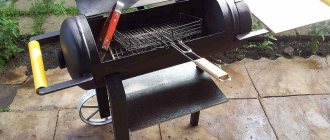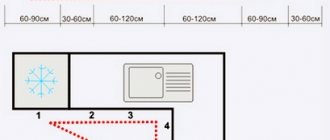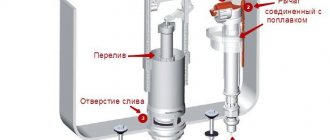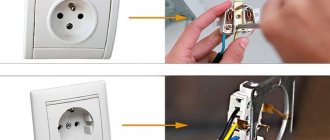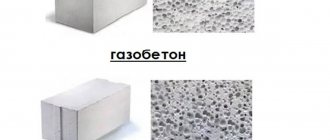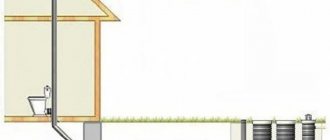This summer I installed plumbing at my dacha. As usual, in order to save money and not buy new parts in stores, you always try to find everything you need in the junk lying around in the barn - old fittings, taps, pipes.
I found several gas taps brought from my old hardware store. I saw that their size was the same as that of water taps - ½ inch.
I thought that, in theory, a gas tap should be more reliable than a water tap and they can be used when installing a water supply system. It’s good that I decided to google first what professionals write about this.
This story was sent by our subscriber Mikhail T.
Design and features of a ball valve for gas
Ball valve for gas
The valve for domestic gas can be used for internal systems and for external lines; elements with a diameter from 2 to 12 inches are most often used. Ball mechanisms are necessary to completely shut off or open the gas flow; their main feature is the locking structure. It has the shape of a ball with a special through hole that corresponds to the diameter of the pipeline. If it is necessary to shut off the fuel supply, turn the valve 90 degrees so that it is located perpendicular to the pipe.
The process of controlling the part is carried out using a lever supplemented with sealed rings. Ball valves have many advantages, including good tightness and high insulating properties. Modern cranes are lightweight due to the use of special metals and alloys, are highly reliable and can be operated for 10 years without malfunctions.
Ball valve prototypes
The plug tap was known to the ancient Egyptians. Simple and reliable, these devices are still used today. Let us recall the most famous options for their use:
- Samovar. The same one with which tea was always poured from samovars, both the most ancient and modern electric ones.
- Bath. KrB is still used in the washing departments of public baths, for which it received its official name.
- Gas. Familiar to everyone who uses a gas stove, water heater or heating boiler that runs on natural gas.
How does a plug valve work?
The simplest device is the samovar version. There are two components: a body and a cone - a plug with a rectangular cutout and a non-removable handle. The body follows the shape of the cork and has the same internal dimensions. By turning the plug 90 degrees, the slot of the plug is installed along the axis of the product, opening the passage for water. The flow is blocked by turning the plug 90 degrees in the opposite direction. The position of the permanent handle indicates the position “Open” if it is parallel to the axis of the “spout”, and “closed” if the handle becomes perpendicular to the axis of the shut-off valve. In this part, cork and ball devices are very similar. The difference is in the locking organ: a cone in a cork device, and a sphere in a ball device. The difference is visible when it comes to the seal between the locking device and the body of the product.
To prevent leaks, plugs made of soft brass or copper were ground to the housings until the gap was completely eliminated, by repeatedly turning them into place. Gas and bath models are more complex because they operate under pressure, and in the case of the gas version, the slightest leak of the working medium will cause an explosion and fire. These models have a closed bottom, an oil seal with a threaded lid. With ball locking devices, rubbing will not help. Spherical polymer seals are used here.
Types of gas taps
Ball valve device
There are various ball valves for domestic gas, differing from each other in design and appearance. All products consist of a standard set of parts:
- body part made of steel, brass or nickel;
- a section for connecting a pipe;
- neck part for the rod;
- a connecting rod that provides connection between the moving mechanism and the handle;
- shut-off ball to shut off gas.
Additionally, the ball is reinforced with a special seat that prevents it from moving, and is held in it with a ring. The seal, flange and springs are responsible for the tightness and connection of parts of the entire structure.
The main part of the device is the handle, which controls the locking mechanism. It is fixed in one place with a strong nut and is complemented by a stopper that limits its movement.
Ball
Internal structure of a ball valve
Faucets for apartments, houses, offices and businesses can be made of brass or nickel. Elements of the first type have good sealing properties, do not cause difficulties during operation and are suitable for water pipes. Their nickel analogues can be full bore or reduced bore, taking into account the throughput. The most common are valves with external and internal threads, welded, flanged and threaded types.
Corner
The corner gas valve is equipped with inlet and outlet pipes located at an angle of 90 degrees towards each other. This structure allows the element to be used when installing units in hard-to-reach places, as well as in areas where bending of the main line is required.
Threaded
Threaded or coupling parts have a small diameter; they are most often used for domestic gas pipelines. They are connected to the pipeline using a threaded connection, from which they get their name.
Flanged
Flange valves are designed for external gas pipelines with a large diameter. The connection in them is carried out using the flange method using bolts. Such elements are dismountable, which makes it possible to dismantle them and then reinstall them in other areas.
Welded
Elements with a welded structure are also used for external gas pipelines; the diameter of such valves ranges from 10-70 mm. They are connected to the pipes by welding, so in the future these installation areas will not be dismountable. The list of advantages of the elements includes optimal tightness and a high level of reliability; in addition, welded fittings do not require additional maintenance.
Threaded
Welded
Flanged
Angular
Fastening methods
Based on the fixation technique, ball valves are classified into the following types.
- Coupling (threaded). The threaded type mechanism is usually used in private water supply systems of small diameter (no more than 65 millimeters), for gas and for heating systems or liquid media. The sleeve valve is distinguished by its ease of installation. To install the device, given that the pipes are threaded in advance, there is no need for specialized tools or highly qualified specialists.
- Flanged. Devices mounted using specialized elements (flanges) are mainly used for installation on industrial pipelines with a diameter of 50 millimeters or more. Such a device is more durable and sealed.
- Welded. Mounted on metal water pipes by welding. The fixation of such a valve is the most reliable, however, installation of the device requires certain qualifications. For the most part, welded valves are installed on industrial gas pipelines where high sealing is required.
- Combined. They are connected to pipes using various methods. Products of this type are endowed with multifunctionality and are used in a variety of communication systems with the following connections: flange connection plus welding, threaded connection plus welding, and others.
Types of ball gas valves
In addition to the fact that the shut-off valves under consideration differ in diameter, the differences lie in the installation method. The following types of devices are used much more often in gas pipelines:
| Threaded (coupled) | They have a small diameter. In most cases, these products are used in domestic gas pipelines. The connection to the pipeline, as you might guess from the name, is made using a threaded connection. |
| Flanged | They are used in external gas pipelines of enormous diameter. The connection is made using the flange method using bolts. Like threaded ones, these devices are collapsible, i.e. they can be dismantled and then reinstalled. |
| Welded | Like flanged ones, they are used for external gas pipelines. Their diameter can range from 10 to 70 millimeters. The connection to the pipeline is carried out by welding. Accordingly, this installation option is non-removable. The advantages of such products include complete tightness and high reliability. In addition, welded shut-off valves do not require maintenance, i.e. tightening flange connections. |
Advice! In addition to ball valves, there are also plug valves. However, they are less reliable and durable, which is why they have recently been used very rarely.
Conclusion
Currently, gas ball valves are widely used in domestic and industrial gas pipelines. This is due to the fact that they are reliable and durable. The only thing is, when choosing which gas tap is better, you should give preference to more expensive devices from well-known manufacturers, since cheap products may not meet the required quality.
You can get some additional information on this topic from the video in this article.
Did you like the article? Subscribe to our Yandex.Zen channel
Differences from plumbing fittings
Water tap painted red
The gas valve differs from the water tap in the appearance of the lever, which is yellow instead of red, as well as in a number of design features:
- long connecting thread;
- more durable housing and locking mechanism;
- ability to withstand high pressure;
- the presence of strong and sealed rings.
Despite the fact that a standard gas faucet is more expensive, it cannot be replaced with water fittings, since such savings may lead to the replacement of the main elements of the system as a result of an accident.
Modern locking mechanism
A simple design guarantees unique performance qualities. Its features include:
- The lock is made in a spherical shape, which determines the main performance qualities.
- The spherical lock has a special hole through which gas passes. Corrosion-resistant materials are used in the manufacture of the sphere. Therefore, it serves for many years.
- Adjustment of the throughput is ensured due to the possibility of rotating the locking mechanism around its axis. Place the lock perpendicular to the pipeline.
The above information determines that the device has only one moving element and high performance.
Features of application
In most cases, ball valves are installed in places where gas equipment is used, for example, in the kitchen, and a separate valve is needed for each source of fuel consumption. Shut-off valves can be used to shut off and control flow, for example, a three-way valve makes it possible to direct flow from one pipeline to the next.
The tap for a standard gas pipe in the kitchen must match the features of the system and the type of equipment. Most often, threaded elements are installed in such rooms, which do not cause problems during installation and throughout the entire service life.
Types of water ball valves
Manufacturers offer a wide variety of shut-off, control and mixing valves.
According to the body configuration, locking products are divided into:
- straight;
- corner;
- tees.
Direct ones are the most popular for home use. Angular ones are installed in places where the direction of flow should be changed and its regulation should be provided. This need for plumbing arises when connecting a dishwasher or washing machine. In heating systems when connecting a radiator to the inlet pipe. Tees are installed in a place where it is necessary to cut off one of the flows or redirect the flow.
Based on the type of housing there are:
- with a solid body - they cannot be repaired if broken;
- with a collapsible body - repairable.
For home plumbing, unless the owner is a professional plumber, purchase solid taps. They are cheaper. If they break, they are replaced.
We recommend that you read: Vacuum valve for sewage systems
Products with a moving ball are limited to a diameter of 20 mm. The ball in the locking mechanism is able to move freely. This provides additional sealing, since the ball presses the flow itself against the gasket material.
Based on cross-country ability, ball valves are divided into:
- Full bore - capacity corresponds to the pipeline.
- Reduced - the throughput is reduced due to the smaller diameter of the hole in the locking mechanism. Such taps are placed on heating lines under pressure to mitigate water hammer.
According to the method of connection to the pipe, they are distinguished:
- Threaded. The thread can be the same on both sides (external, internal). Or different, when on one side it is external and on the other internal.
- Combined - on one side there is a thread (any), on the other there is a fitting.
- Designed for welded joints. These are rarely used in the home plumbing system.
- Flanged - have flanges at the ends and are a main version of the locking device.
In individual water supply systems, the first and second types of ball valves are mainly used. The threaded connection is easy to install and can be quickly disassembled if necessary.
According to their performance characteristics, ball valves are distinguished:
- low and high temperature;
- for operation under different pressures, from 16 to 40 atm.
Manufacturers offer a wide selection of ball valve sizes, from standard ½ inch to 200 mm valves.
Based on the material of the case, they are distinguished:
- steel;
- brass;
- polymer - made of unplasticized polyvinyl chloride.
Brass ones are the most expensive, but also the most reliable. Their service life is longer than that of steel (they do not corrode in an aquatic environment). There are no restrictions on the scope of use like plastic ones.
Steel ones are rarely used when installing home communications. Their main area of use is industry.
Polymer ball valves are widely used in the installation of individual water supply systems. Manufacturers offer a range of sizes from 20 mm to 63 mm. The service life of polymer ball valves is guaranteed for 15 years. They are not subject to corrosion. They have a reliable locking mechanism with a floating ball. The push-in connection allows the unit to be dismountable.
We recommend that you read: How to properly secure a sewer pipe to a wall - types of fasteners and installation methods
Note! The area of application of polymer taps is limited to cold water supply. PVC shut-off devices are not intended for use at high temperatures.
Technical description
The first thing to consider is the design of the ball valve.
Structure
Gas ball valve design
| Designation in the figure | Name |
| 1 | Hull part. Most often found in brass or steel. |
| 2 | Connection pipe. May have a threaded or welded connection. |
| 3 | The throat part. The rod passes through itself. |
| 4 | Connecting rod. Connects the handle and the ball together. |
| 5 | Restriction washer. |
| 6 | Check ball. Directly closes and opens the passage. |
| 7 | Saddle. Positions the ball in the desired location. |
| 8 | Ring support. Holds the saddle. |
| 9 | Spring. |
| 10 | O-ring seal. |
| 11 | Ring. |
| 12 | Flange. |
| 13 | Lever. |
| 14 | Seat seal. |
| 15 | Fixing nut. Holds the handle. |
| 16 | Stopper. |
Principle of operation
Steel hollow ball
The most important and basic part of the gas valve under consideration is the shut-off ball, which has a through hole equal to the diameter of the connecting pipe and is connected to the switch handle by a rod. The instructions for the operation of such a mechanism are elementary:
The instructions for the operation of such a mechanism are elementary:
- The person, with a slight movement of his hand, turns the handle 90 degrees.
- The rod transmits this movement to the ball.
- The wall changes to a hole, creating a free passage.
Advantages
Ball gas valve KShG made of steel
Ball valves for gas pipelines have a whole range of positive aspects:
- Relatively low price. This is achieved due to the simplicity of the design, eliminating the use of expensive components.
- Light weight. Does not weigh down the pipeline, which allows you to limit yourself to standard pipe fastenings.
Conventional fastening for gas pipeline
High reliability. In manufacturing, only high-strength materials are used.
The reliable brass body of the gas ball valve is not subject to corrosion processes
- High speed and easy DIY operation. Just a short turn of the handle is enough to change the position from “open” to “closed” and vice versa.
- No maintenance required. Such shut-off valves can be safely installed in hard-to-reach places.
- High tightness of flow shutoff. The closed position of the valve guarantees complete sealing of the gas pipeline.
- Possibility of installation even under water. In this case, the penetration of liquid into the system is absolutely excluded.
- Small sizes. They allow the product not to stand out against the background of the pipe itself and simplify its installation, which can easily be performed by 1-2 people.
Ball valve on gas pipe
- Attractive appearance. The only part that stands out is the handle, which can be made in the form of a butterfly or an elongated lever. In any case, the technical unit looks quite aesthetically pleasing.
- Easy to install. Both threaded and welded connections are possible.
Technical data
Valve with butterfly handle and nominal bore 15 mm
Let's look at the parameters of the classic model for installation on a home gas pipeline:
| Parameter | Meaning |
| Section | 1.5 cm or ½ inch |
| Number of turns on a threaded connection | 6-7 |
| Tightness indicator | Class A |
| Withstand pressure | Not less than 6 MPa |
| Permissible temperature | From -20 to +130 degrees Celsius |
| Housing material | Brass grade LS-59-2 |
| Handle type | Butterfly |
| Handle color | Yellow in accordance with the gas pipeline designation rules |
| Gasket material | Fluoroplastic |
| Threaded connection for pressure gauge | G ½ / G ½ |
| Types of threaded connections | Inner-outer and inner-inner |
| Product height | 5.8 cm |
| Length including handle | 6.7 cm |
| Body length | 6.7 cm |
| External diameter | 3.3 cm |
Possible varieties
It should also be noted that gas ball valves may differ from each other in some features, namely:
If possible, carry out repairs. There are dismountable and all-welded samples.
In addition, there are models that have an electric drive, which allows you to automate the process of closing and opening it.
Features of replacing a gas valve
Ball valves of any type are not immune to breakdowns, so if a fault is detected, the element must be urgently replaced. It is better to entrust this work to gas service specialists. A new tap is purchased based on the diameter of the gas pipeline, which must correspond exactly to it.
Before the expert arrives, you need to light the gas on the stove and close the valve, directing the burner and waiting for it to completely extinguish to allow the remaining fuel to exit the gas pipeline. After completing the work, the specialist must definitely test the shut-off valves for leaks and enter information about replacing the element in the technical passport.
Gas valve in an apartment: which one to choose and how to change it
The pipes supplying gas to the stove must be equipped with an individual tap, which serves to shut off the gas supply in the event of a leak or malfunction of the gas stove. The gas valve requires constant monitoring and timely maintenance. If a faucet malfunction is detected, an urgent replacement of the device is required.
Gas shut-off valve in the apartment
Features of replacing a gas tap
Of course, every shut-off valve can fail; for example, gas taps are not insured against failure. If a malfunction of this device is detected, it must be replaced immediately.
Let us immediately declare that doing this work with your own hands is not allowed! But, some actions will still need to be performed independently.
So, the instructions for replacing this shut-off valve are as follows:
- First of all, it is necessary to tell about the problem to experts from gas work or a personal organization that holds a license to perform similar work.
- After this, you need to purchase a new faucet from a specialized store. You must first measure the diameter of the pipeline so as not to make a mistake when choosing a product.
- When the experts arrive, prepare a technical passport and a gas supply contract. A technical passport is needed to make notes on the work performed.
- After this, you need to light the gas on the stove and turn off the central valve. Leave the burner until it completely extinguishes, so that all the gas leaves the pipeline.
- Upon arrival of experts, it is necessary to open a couple of windows in order to create a draft in the room. This is necessary in case of a gas leak.
- Upon completion of the work, work together with experts to diagnose the installed shut-off valves for leaks.
- At the end of the work, it is necessary to give the workers a technical passport and ask them to make a note in that direction.
Advice! It is possible to identify a gas leak using soap foam. It must be applied to the connection points between the device and the pipeline, and to the valve itself. If a soap ball forms in some place, it means that the shut-off valve is letting gas through.
Upon completion of work, leave the windows open for another 15-30 minutes, which will ensure complete ventilation of the room.
Main settings
Shut-off valves are an essential element of a gas pipeline, which is used both on external pipelines and on internal systems; only the diameter and size differ. For domestic gas pipelines in an apartment or private house, a gas ball valve with a diameter of 2-1/2 inches is used.
A separate valve is installed for each source of consumption - if a boiler and a gas stove are installed in the house, there must be at least 2 taps.
Shut-off valves on the gas pipeline in the apartment
If bottled (liquefied) gas is used, shut-off valves are not required. The cylinders already have a valve installed that regulates the fuel supply.
When choosing the best option, you need to consider several factors. There are 2 types of valves:
Ball valve 3/4 inch diameter
A plug valve is characterized by a loose connection and a shorter service life. Today they are no longer used.
It should be noted that the second version of the gas valve is divided into subtypes according to the fixation method:
It is used for household gas pipelines and has a small diameter. The connection to the pipe is made through a thread. The crane is collapsible.
Scope of application – pipelines of increased diameter. The connection is established by assembling the flanges with bolts. Collapsible design.
Used for large pipelines with a diameter of up to 70 mm. Welded to the main line, dismantling is not allowed. Can only be used once.
With a threaded and flanged connection, you can easily replace the gas tap in your apartment with a new one or remove and install it back several times. The welded valve is installed only once.
VIDEO: Ball valve design
What to consider when buying a gas tap
To buy a high-quality standard or corner gas valve, you need to pay attention to the following nuances:
VIDEO: How to spot fake Bugatti taps
Installation of shut-off valves
Depending on the type of locking element, you can install it yourself without the involvement of specialists. To do this, you need to study in detail how to change the gas tap in an apartment and prepare all the necessary tools.
Ball valve installation and repair diagram
To work you will need:
During installation work, open windows and doors in the room, and turn off electrical equipment. The best option would be to turn off the electric meter before installation. This will provide a safe environment for this task.
How to check a joint for leaks
The final stage of installing a gas tap is to check its connection for leaks. To do this, prepare a concentrated soap solution to lubricate the gas valve on the boiler, or more precisely, the area where it is fixed to the pipe.
Be sure to check for leaks before starting
The soap must be as foamy as possible, otherwise it will be impossible to detect a leak if it occurs.
Next, open the valve so that gas begins to flow from the gas pipeline and carefully observe the process. If the element itself or the junction allows fuel to pass through, the soap solution will begin to foam. Here you will need to turn off the gas supply, remove the shut-off part and install it again.
A few words in conclusion
Experts do not recommend using welded type cranes. Despite the fairly robust design, if a mistake is made, welding can leak gas, and to solve the problem, you will need to carry out the work again, but with a new valve. Therefore, it is better to give preference to threaded variations.
Remember! Carrying out self-installation is considered a very risky and unsafe activity. If you do not have the necessary experience, it is recommended to turn to gas workers, especially since the price for their services is reasonable - 300-500 rubles.
VIDEO: How to replace a gas tap
Source
Operating rules
A dielectric coupling is necessary to reduce the impact of stray currents
In order for the ball valve for domestic gas to last as long as possible, standard recommendations must be followed during its maintenance. The element is designed to quickly shut off the gas flow inside the pipeline. It can only be opened and closed using the factory handle; it is prohibited to use any tools for this purpose.
The design of the valve itself is not intended for flow control; the element has only two operating positions: open and closed. If it is half-open, the rapid flow of pumped fuel can cause deformation of the sealing rings, as a result of which the valve will quickly become unusable and will have to be replaced. The element must not be used in environments with contaminants that could cause mechanical damage to the gaskets. Sometimes the fastenings of the rotary handles become loose, in such cases it is necessary to tighten the screws securing them. If there are leaks in the stuffing box seals of the rods, adjust the nuts located under the valve handles.
According to instructions from crane manufacturers, any repair work, including replacement of the device, is prohibited from being carried out independently without the necessary skills.
Sources of danger
There are, in fact, only two of them.
The fact is that independent work related to opening the gas pipeline will inevitably lead to a gas leak.
- At a certain concentration of natural gas or propane-butane mixture in the air, it will become unbreathable.
- Long before this, the gas-air mixture will become explosive. The slightest spark when turning on an electrical appliance, triggering any relay (for example, a convector thermostat) or clicking a light switch will lead to exactly the consequences that we tried to warn the reader against in the first section of the article.
The rules that will help avoid negative consequences are quite obvious.
- All work is carried out with windows wide open throughout the entire apartment or house. Yes, yes, regardless of the time of year. Don’t be afraid that your favorite cactus will freeze: if everything goes well, forced ventilation will last no more than 10 minutes.
- The room must be completely de-energized. What the instructions relate to is, I think, clear from the previous explanation. Take it seriously: as already mentioned, the cost of a mistake can be the highest.
Purpose
The definition of “ball valve” is equally applicable to a water tap and a valve. These two types of cranes are distinguished by location and purpose. The water tap is the end point of the water supply; the valve is installed between the elements of the water supply.
Ball valves for water supply are designed to completely shut off the main line or to regulate the flow. In shut-off valves, the design provides for two operating positions “closed” and “open”, excluding intermediate ones. To reduce the water supply, redirect the flow or mix two flows, ball valves of a different design are used, which are specially designed for these purposes.
Note! Operating a shut-off ball valve in a half-closed position will lead to its rapid failure.
A ball stop valve is installed on water pipes:
- for each branch of wiring to household appliances (water heater, washing machine, dishwasher);
- for each water supply line leading to the sink, bathtub, shower;
- for an individual outlet from the main water supply line (for introducing a water supply system into an apartment or house).
The installation scheme of an internal water supply system with the installation of a shut-off device on each section of the distribution somewhat increases the cost and complicates the installation of communications, but in the long term it is more profitable. In the event of a pipe break or failure of any household appliance, a ball valve allows you to quickly shut off the water supply to the problem area. At the same time, residents still have the opportunity to use running water.
A water-folding ball valve is installed separately for cold or hot water, and is also a common type of mixer. A ball mixer is a valve that is opened and closed not by rotating a knob, but by a lever, turning it left and right to adjust the temperature and up and down to control the flow force.
Note! A regulating ball valve for water supply can be installed to save water consumption for drainage, for example, at a kitchen sink. Here it will combine all the functions: flow reduction, complete overlap, free flow.
Ball valves are used in classic individual heating systems and when installing heated floors. Shut-off valves allow you to isolate individual radiators from the main system, thus regulating the temperature in the room. In the event of a radiator breakdown, this allows you to avoid stopping the heating operation for repairs.
We recommend that you read: Pressure pipes for communications made of polyethylene - characteristics and scope of use
The choice of shut-off valves for a heating system is limited by certain requirements for temperature and internal pressure. Not every ball valve is suitable for this due to its operational characteristics.
Manufacturers of household gas taps
When choosing shut-off valves, you need to pay attention to all the details and purchase only high-quality products from well-known manufacturers. Products from Italian companies FIV, Valtec and Bugatti have proven themselves best. Devices from the German brands Dungs and Profactor, the Polish brands Broen Ballomax and Efar, as well as the Russian concern LD are also of good quality.
It is not recommended to save money and give preference to Chinese manufacturers, since such fittings do not meet international standards and requirements.
Basic criteria for choosing equipment
If there is a question about replacing the gas tap, then doing it yourself is not recommended. Only specialists have the right to engage in such work, and they must have a license for these types of work. Replacing gas pipes and taps yourself is simply unacceptable. You can endanger not only your life, but also the lives of your family and neighbors.
Every homeowner and tenant should know this information. It is the gas workers who carry out periodic inspections of the condition of gas equipment or, in case of problems, the owner of the property calls the emergency gas service. They, in turn, determine what is out of order, and residents buy everything they need to fix the breakdowns. In this case, we will find out what criteria are best for choosing a gas tap.
As previously mentioned, ball valves are popular, although experts in this industry say that plug valves last longer - their service life is about 20 years. They just need to be maintained and occasionally lubricated. But ball ones - no.
So when choosing, you should pay attention to all the little things, even the appearance of the product and take into account the following circumstances:



